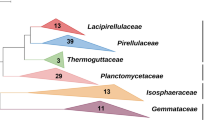Abstract
The budding and/or appendaged bacteria are a heterogeneous collection of unicellular microbes. Organisms in this group may differ from typica eubacteria in their mode of reproduction (budding) unusual shapes, and complex life cycles. However, like eubacteria, motile forms have flagella, and with the exception of Metallogenium and certain Planctomyces isolates, all have rigid cell walls. Thesse bacteria are primarily free-living organisms widely distributed in terrestrial and aquatic ecosytems. Our knowledge of the group is increasing rapidly as new members are discovered, isolated, and characterized. Approximately half the organisms in this group have either been discovered or isolated for the first time during the past decade.
Access this chapter
Tax calculation will be finalised at checkout
Purchases are for personal use only
Preview
Unable to display preview. Download preview PDF.
Similar content being viewed by others
Literature Cited
Aristovskaya, T. V. 1964. The taxonomic position of the genus Seliberia Artist, et Parink. Microbiology [English translation of Mikrobiologiya] 33:929–934.
Babenzien, H.-D. 1967. Zur Biologie von Nevskia ramosa. Zeitschrift für Allgemeine Mikrobiologie 7:89–96.
Babenzien, H.-D. 1974. Fine structure and systematic position of the caulobacterium Nevskia ramosa, p. 15. XIth Conference on the Taxonomy of Bacteria, Brno. Abstracts.
Conti, S. F., Hirsch, P. 1965. Biology of budding bacteria. HI. Fine structure of Rhodomicrobium and Hyphomicrobium spp. Journal of Bacteriology 89:503–512.
Dubinina, G. A. 1978. Biologiya zhelezobacteriy i ikch geokchemicheskaya deyatelnost. [Biology of the iron bacteria and its geochemical activity.] PhD. Thesis. International Microbiology Academy of Sciences, USSR, Moscow.
Duchow, E., Douglas, H. C. 1949. Rhodomicrobium vannielli, a new photoheterotrophic bacterium. Journal of Bacteriology 58:409–416.
Gorlenko, V. M. 1968. A new species of green sulfur bacteria. Doklady Akademii Nauk SSSR, Biological Sciences [English translation] 179:195–198.
Gorlenko, V. M., Lebedeva, E. F. 1971. New green sulfur bacteria with appendages. Microbiology [English translation of Mikrobiologiya] 40:900–903.
Henrici, A. T., Johnson, D. E. 1935. Studies of freshwater bacteria II, stalked bacteria, a new order of Schizomycetes. Journal of Bacteriology 30:61–93.
Hirsch, P. 1974. Budding bacteria. Annual Review of Microbiology 28:391–444.
Houwink, A. L. 1951. Caulobacter versus Bacillus spec. div. Nature 168:654.
Metchnikoff, M. E. 1888. Pasteuria ramosa, un représentant des bactéries à division longitudinale. Annales de l’Institut Pasteur 2:165–170.
Nikitin, D. I., Vasileva, L. V., Lokmacheva, R. A. 1966. New and rare forms of soil microorganisms. [In Russian.] Moscow: Science Publishing House.
Nikitin, D. I., Kuznetsov, S. I. 1967. Electron-microscope study of the microflora of water. Microbiology [English translation of Mikrobiologiya] 36:789–794.
Pate, J. L., Ordal, E. J. 1965. The fine structure of two unusual stalked bacteria. Journal of Cell Biology 27:130–143.
Perfilev, B. V., Gabe, D. R. 1964. Rol mikroorganizmov v obrazovanii zhelezokargantsevikh ozernikh rud. [Methods for the study of bacteria accumulating manganese and iron in bottom deposits.] In: Gurevich, M. S. (ed.), The role of microorganisms in the formation of iron-manganese lake ores. Moscow and Leningrad: Nauka.
Pfennig, N. 1969. Rhodopseudomonas acidophila, sp. n., a new species of the budding purple nonsulfur bacteria. Journal of Bacteriology 99:597–602.
Poindexter, J. S. 1964. Biological properties and classification of the Caulobacter group. Bacteriological Reviews 28:231–295.
Sayre, R. M., Wergin, W. P. 1977. Bacterial parasite of a plant nematode: Morphology and ultrastructure. Journal of Bacteriology 129:1091–1101.
Sayre, R. M., Adams, J. R., Wergin, W. P. 1979. Bacterial parasite of a cladoceran: Morphology, development in vivo, and taxonomic relationships with Pasteuria ramosa Metchnikoff 1888. International Journal of Systematic Bacteriology 29:252–262.
Sayre, R. M., Wergin, W. P., Davis, R. E. 1977. Occurrence in Monia sic rectirostris (Cladocera: Daphnidae) of a parasite morphologically similar to Pasteuria ramosa (Metchnikoff, 1888). Canadian Journal of Microbiology 23:1573–1579.
Staley, J. T. 1968. Prosthecomicrobium and Ancalomicrobium: New prosthecate freshwater bacteria. Journal of Bacteriology 95:1921–1942.
Staley, J. T. 1973a. Budding and prosthecate bacteria. In: Laskin, A. L, Lechevalier, H. A. (eds.), Organismic microbiology. Handbook of microbiology, vol. 1, 1st ed. Cleveland, Ohio: CRC Press.
Staley, J. T. 1973b. Budding bacteria of the Pasteuria-Blastobacter group. Canadian Journal of Microbiology 19: 609–614.
Whittenbury, R., Dow, C. S. 1977. Morphogenesis and differentiation in Rhodomicrobium vannielii and other budding and prosthecate bacteria. Bacteriological Reviews 41:754–808.
Whittenbury, R., McLee, A. G. 1967. Rhodopseudomonas palustris and Rh. viridis—photosynthetic budding bacteria. Archiv für Mikrobiologie 59:324–334.
Zavarzin, G. A. 1961. Budding bacteria. Microbiology [English translation of Mikrobiologiya] 30:774–791.
Editor information
Editors and Affiliations
Rights and permissions
Copyright information
© 1981 Springer-Verlag Berlin Heidelberg
About this chapter
Cite this chapter
Staley, J.T., Hirsch, P., Schmidt, J.M. (1981). Introduction to the Budding and/or Appendaged Bacteria. In: Starr, M.P., Stolp, H., Trüper, H.G., Balows, A., Schlegel, H.G. (eds) The Prokaryotes. Springer, Berlin, Heidelberg. https://doi.org/10.1007/978-3-662-13187-9_29
Download citation
DOI: https://doi.org/10.1007/978-3-662-13187-9_29
Publisher Name: Springer, Berlin, Heidelberg
Print ISBN: 978-3-662-13189-3
Online ISBN: 978-3-662-13187-9
eBook Packages: Springer Book Archive




